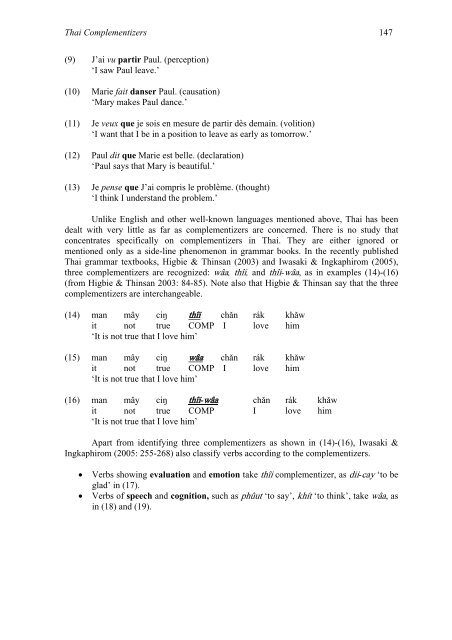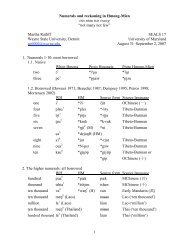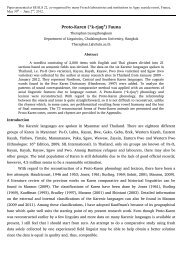proto-southwestern-tai revised: a new reconstruction - seals 22
proto-southwestern-tai revised: a new reconstruction - seals 22
proto-southwestern-tai revised: a new reconstruction - seals 22
You also want an ePaper? Increase the reach of your titles
YUMPU automatically turns print PDFs into web optimized ePapers that Google loves.
Thai Complementizers 147<br />
(9) J’ai vu partir Paul. (perception)<br />
‘I saw Paul leave.’<br />
(10) Marie fait danser Paul. (causation)<br />
‘Mary makes Paul dance.’<br />
(11) Je veux que je sois en mesure de partir de›s demain. (volition)<br />
‘I want that I be in a position to leave as early as tomorrow.’<br />
(12) Paul dit que Marie est belle. (declaration)<br />
‘Paul says that Mary is beautiful.’<br />
(13) Je pense que J’ai compris le proble›me. (thought)<br />
‘I think I understand the problem.’<br />
Unlike English and other well-known languages mentioned above, Thai has been<br />
dealt with very little as far as complementizers are concerned. There is no study that<br />
concentrates specifically on complementizers in Thai. They are either ignored or<br />
mentioned only as a side-line phenomenon in grammar books. In the recently published<br />
Thai grammar textbooks, Higbie & Thinsan (2003) and Iwasaki & Ingkaphirom (2005),<br />
three complementizers are recognized: wâa, thîi, and thîi-wâa, as in examples (14)-(16)<br />
(from Higbie & Thinsan 2003: 84-85). Note also that Higbie & Thinsan say that the three<br />
complementizers are interchangeable.<br />
(14) man mây ciŋ thîi chǎn rák khǎw<br />
it not true COMP I love him<br />
‘It is not true that I love him’<br />
(15) man mây ciŋ wâa chǎn rák khǎw<br />
it not true COMP I love him<br />
‘It is not true that I love him’<br />
(16) man mây ciŋ thîi-wâa chǎn rák khǎw<br />
it not true COMP I love him<br />
‘It is not true that I love him’<br />
Apart from identifying three complementizers as shown in (14)-(16), Iwasaki &<br />
Ingkaphirom (2005: 255-268) also classify verbs according to the complementizers.<br />
• Verbs showing evaluation and emotion take thîi complementizer, as dii-cay ‘to be<br />
glad’ in (17).<br />
• Verbs of speech and cognition, such as phûut ‘to say’, khít ‘to think’, take wâa, as<br />
in (18) and (19).





